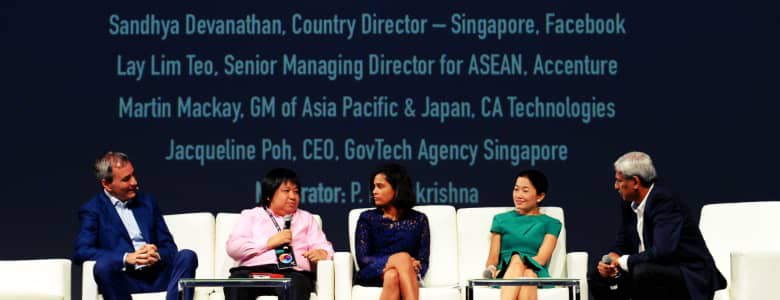Riding together on the Smart Nation journey

Need to get somewhere in a hurry?
Thanks to the recent proliferation of private bike-sharing operators in Singapore, you’re unlikely to be very far from two-wheelers available for hire.
This trend has been driven partly by the companies’ use of mobile apps, GPS technology and QR codes, which eliminate the need for physical bicycle docking stations.
In response, the Singapore government has since shelved its plans to start its own bike-sharing pilot scheme.
It is now involved in a different way — by working with companies to mitigate the negative social issues arising from bike-sharing, such as illegal parking in public spaces.
“This is an example of government and industry working together to make a digital solution available to people in a way that is more palatable,” said Government Technology Agency of Singapore (GovTech) chief executive Ms Jacqueline Poh.
Ms Poh was speaking on 20 September at the Women in Tech 2017 conference, held as part of the Singapore Week of Innovation and Technology (SWITCH), on the topic of ‘Smart Cities: Government-Led or Industry-Led Approaches?’
So, the question is: Which will it be?
Both types of approaches have their merits, and governments and industry will both have important parts to play in the process of digital transformation, said Ms Poh.
The Middle Path
The role of governments, said Ms Poh, is first and foremost to build the country’s digital infrastructure.
In Singapore, this means developing and rolling out platforms such as a unified e-payments system, a national digital identity, and a nation-wide smart sensor network — challenges that no one company can handle on its own.
Another part that governments should play is that of being an enabler for industry.
“We have to create regulatory sandboxes for areas such as fintech and autonomous vehicle implementation, so that technologists can come and try out their ideas,” said Ms Poh. “We’ve done that quite successfully.”
The tech industry, for its part, really needs to push and promote its commercial solutions.
“Most companies and government agencies are not going to know about the latest technologies,” said Ms Poh. “They’re not going to understand the implications of those technologies on their business models unless the industry steps up.”
Summarising, Ms Poh said that government-led approaches are ideal for large-scale projects that involve citizens, or that require defined interoperability standards or huge capital investments in digital infrastructure.
On the other hand, industry-led approaches work for smaller-scale projects that depend on newer and more cutting-edge technology.
The key to success is figuring out the right mix.
For example, Singapore’s artificial intelligence programme AI.SG is government-led but also has close ties to industry, academia and the institutes of higher learning, said Ms Poh.
“In the end, if we want to build a Smart Nation, we have to find a point that’s in the middle. We have to oscillate a bit like we did with bike-sharing, and find a way to have that handshake between industry- and government-led approaches,” she added.
Diversity in a digital world
In the course of her work, Ms Poh often meets other women who lead smart city efforts in their own countries, she told the Women in Tech audience.
“This is a wonderful sign of how we’ve progressed and what we can do in terms of digital transformation,” she said.
But the issues surrounding diversity and technology also extend beyond gender, she noted.
Speaking at a panel discussion on ‘Leadership in the Fourth Industrial Revolution’ later on the same day, Ms Poh added that Singapore is paying special attention to how it can include seniors in the country’s journey towards digitalisation.
“A big part of why seniors find it difficult to interact with digital technology is that it’s just not usable for them — it wasn’t designed by people who look like them, think like them and use things like them,” she said.
When developing and implementing services such as e-payments and two-factor authentication, the needs of seniors must be taken into account along with those of millennials.
“The reason I’m so big on the idea of interoperability in the payments market is because fragmentation is confusing for our senior population. There is no way they are going to regard something with so many different formats as usable,” she added.
The topic of diversity in the workplace also came up in the panel discussion.
When working to improve diversity, it also helps to explicitly state one’s goals, said Ms Teo Lay Lim, Senior Managing Director (ASEAN and Singapore) at Accenture, who also spoke on the panel.
Her company’s aim is to bring the percentage of women on its staff up to 50 percent by 2025.
“There’s a difference when you declare that that’s what you want to do as an organisation, because then it means a lot to employees and to people in the industry,” she said.
“It becomes embedded in the company’s thought processes—you’re actually living it, as opposed to it being something that you just think about every so often.”
https://www.tech.gov.sg/media/technews/riding-together-on-the-smart-nation-journey
